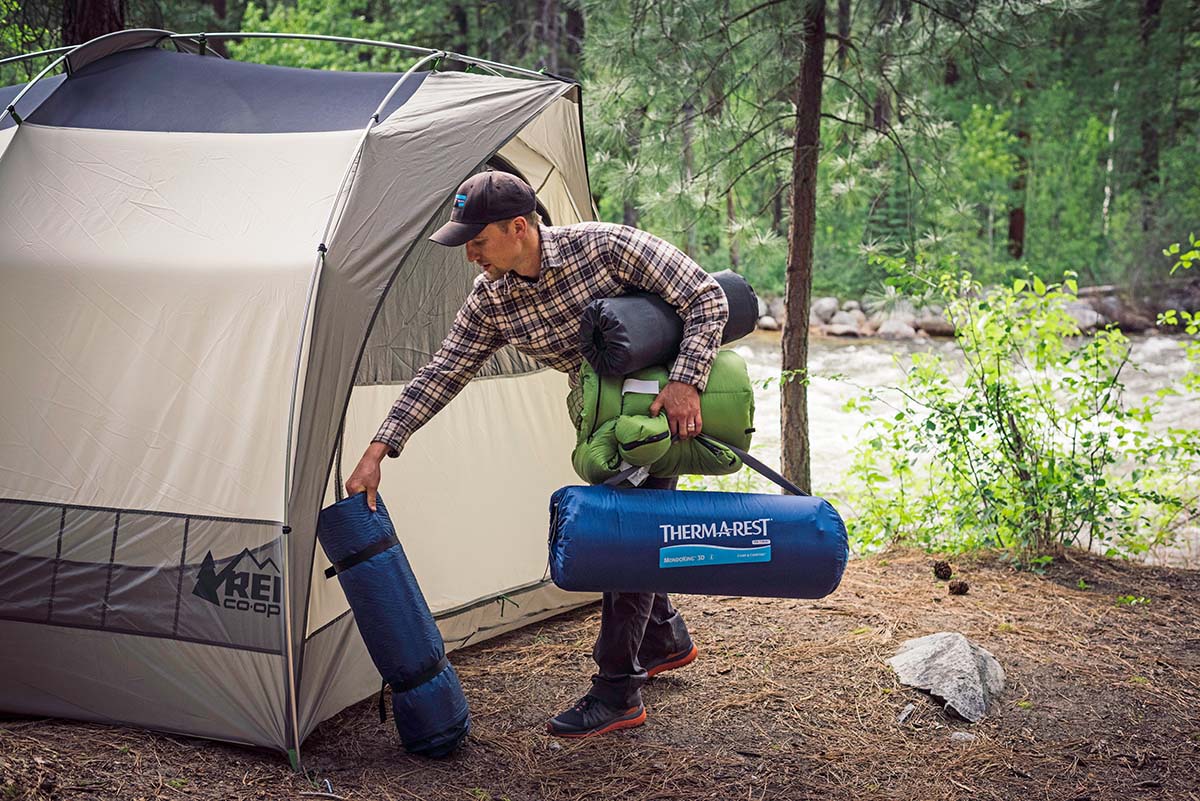
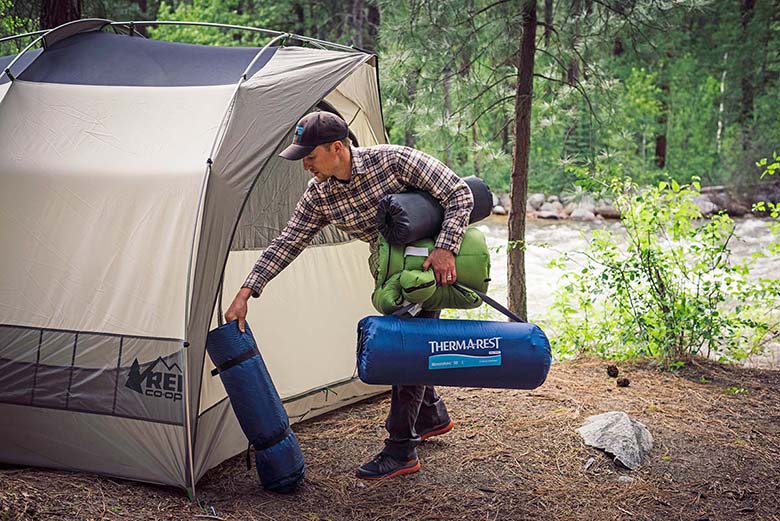
Well-versed campers are comfort experts, and one item they often don’t compromise on is a sleeping mattress. Unlike backpacking, where weight and packed size are limitations, car camping mats emphasize plush cushioning and support with thick foam and soft-touch materials. Below are the best camping mattresses and pads of 2024, ranging from versatile self-inflating mats and air pads to luxurious air beds. For more information, see our comparison table and buying advice below the picks. To complete your camping kit, we’ve also tested and written about camping tents and sleeping bags, as well as backpacking sleeping pads if you'd rather keep things small and light.
Editor's note: This article was updated on July 25, 2024, to remove an outdated product from Coleman, update all pricing and product info, and add more information about our testing philosophy and history.
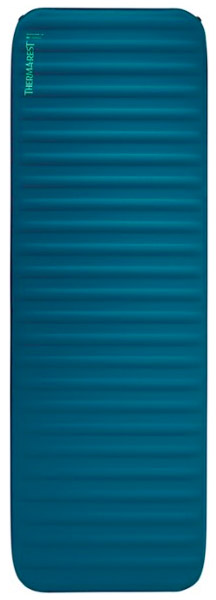 Type: Self-inflating mat
Type: Self-inflating mat
Dimensions: 77 x 25 x 4.25 in. (L)
Weight: 4 lb. 6.0 oz.
R-value: 7
What we like: Pure camping luxury.
What we don’t: You’re paying a premium for the Therm-a-Rest name.
The formula isn’t revolutionary—a self-inflating mat with a soft foam core—but the way the MondoKing 3D executes this is camping luxury. Most notably, the MondoKing is a substantial 4.25 inches thick, and the vertical sidewalls allow you to enjoy every part of the cushy 77- by 25-inch platform. The foam is plush and supportive, and the strong fabrics are soft to the touch and highly tear-resistant. Compared to the past version, the latest MondoKing also includes Therm-a-Rest’s updated valves with dedicated inflate/deflate functions to shorten set up and take down, along with an offsetting foam design that trimmed about a pound of weight and makes it easier to compress and pack.
What’s not to like with the Therm-a-Rest MondoKing 3D? Price is the most glaring downside, with the large model here coming in at a steep $240 (the longer and wider XXL version is $275). If value is a top consideration for you, Exped’s $170 DeepSleep Mat 7.5 below has a higher R-value of 9 and is ever-so-slightly wider, although it’s 5 inches shorter and 1.25 inches thinner. The DeepSleep also doesn’t come with a pump, which many users point out is necessary for inflating the pad fully (the MondoKing’s stuff sack moonlights as the pump). And importantly, the MondoKing components and construction are decidedly premium and confidence-inspiring, which does help justify the cost. For comfort-focused campers who get out regularly and want a pad that will last, we think the MondoKing is the most well-rounded design currently on the market.
See the Therm-a-Rest MondoKing 3D
 Type: Self-inflating mat
Type: Self-inflating mat
Dimensions: 77.6 x 52 x 4 in. (LW Double)
Weight: 9 lb. 14.7 oz.
R-value: 8.1
What we like: Extremely comfy and fits two sleepers.
What we don’t: Very expensive and not as versatile as a one-person mat.
Exped’s MegaMat Duo 10 combines the dimensions of a full-size air bed with the luxurious comfort of a foam self-inflating pad. The net result is an excellent night’s sleep for two campers: The 4-inch-thick cushioning and vertical sidewalls rival the Therm-a-Rest MondoKing above, but the one-person MondoKing can’t touch the Duo’s 52-inch width. With fairly easy inflation/deflation via two large valves and a durable construction, the MegaMat checks off all the boxes for a pair of comfort-oriented campers (we’ve also found it useful as a backup bed for guests at home).
The biggest downside of the Exped MegaMat Duo 10 is price. At a whopping $400, it’s one of the most expensive pads to make our list (just behind the luxurious Hest Sleep System below). It makes more sense if you factor in purchasing two separate premium pads like the $240 MondoKing, but owning a double like the Duo can be overkill when camping by yourself (although too much room isn’t necessarily a bad thing). And a much smaller gripe: The included foot pump is inefficient and only helpful for topping the mat off (it’s best to wait for it to self-inflate or invest in the new $65 Mega Pump). Regardless, the comfort and quality of the Duo are tough to beat. And for the ultimate in camping luxury, Exped makes a Max 15 variation that increases thickness from 4 inches to a whopping 6 inches. Bulk and cost also go up, with the Long Wide Double size coming in at $500... Read in-depth Duo 10 review
See the Exped MegaMat Duo 10
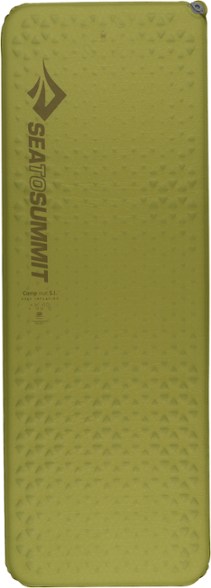 Type: Self-inflating mat
Type: Self-inflating mat
Dimensions: 72 x 25 x 1.5 in. (Rectangular Wide)
Weight: 2 lb. 7.0 oz.
R-value: 4.2
What we like: An affordable and proven self-inflating design.
What we don’t: Tied for the thinnest pad on our list.
Sea to Summit’s Camp collection targets the entry-level end of the market and includes both tapered mummy designs and roomier rectangular models. We’ve included the mid-range Rectangular Wide version here, which is affordably priced but doesn’t sacrifice much in the way of quality. For just $89, you get a durable construction with thick fabrics, a three-season-ready R-value of 4.2, and a simple but functional one-way valve for quick and easy inflation and deflation. At 2 pounds 7 ounces and 8 x 13.5 inches when packed, the Camp is also pretty lightweight and packable for a car camping design, checking in just 6 ounces heavier than Nemo's Quasar 3D air mat below (the tapered mummy versions are even lighter and more compact). If you plan to add any backpacking to the mix, the low heft and good compressibility make the Camp a nice crossover option.
The biggest red flag with the Camp Self-Inflating Sleeping Mat is its 1.5-inch thickness, which is tied for the thinnest on our list (along with REI’s similarly budget-friendly Trailmade below). Simply put, it lacks the cushioning to be a suitable option for side sleepers or those who value plush and supportive padding. On the bright side, Sea to Summit does make an upgraded Camp Plus SI model that’s 3 inches thick and costs $10 more for the Rectangular Wide version. But for those who sleep on their back and aren’t too finicky about comfort, the standard model can do the trick for less.
See the Sea to Summit Camp SI
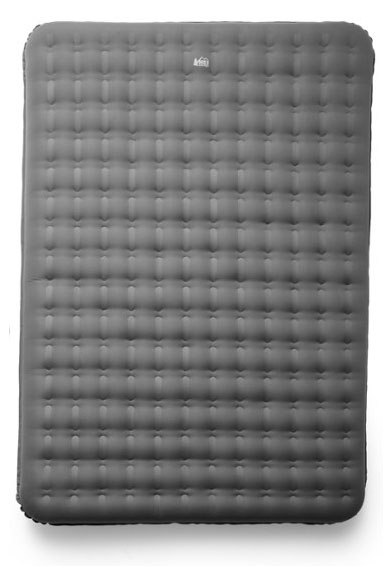 Type: Air bed
Type: Air bed
Dimensions: 79 x 56 x 6 in. (Queen)
Weight: 5 lb. 13.0 oz. (without pump)
R-value: 2.6
What we like: Comfortable, well built, and affordably priced.
What we don’t: Air beds take a long time to inflate and don’t insulate very well in cold temps.
Springing for a full-on air bed is a great option for couples, families, or those who just like the extra space. Our favorite outdoor-ready design in this category is REI’s Kingdom Insulated Air Bed. The Kingdom gets you farther off the ground than the self-inflating models above (6 in. to be exact), which translates to impressive comfort and cushioning. You also get a quality and durable build, separate inflation and deflation valves for ease of use, and welded seams to help prevent leaks. And like the Exped above, the Kingdom can pull double duty as a guest bed at home, which only adds to its all-around value.
What are the downsides of choosing an air bed like the REI Kingdom? For starters, the Kingdom takes a long time to inflate with the included manual pump (investing in a portable, electric pump is wise). Second, air beds don’t insulate you as well from the ground as a typical camping mat (air is no match for foam when it comes to trapping warmth), and the REI’s R-value of 2.6 means you’ll want to leave it at home if the nighttime temperatures will be especially cold. Finally, if you do happen to get a puncture, it can be a real pain trying to locate and fix a leak. But this issue isn't specific to the Kingdom, and there's no denying the boost in comfort.
See the REI Co-op Kingdom Insulated
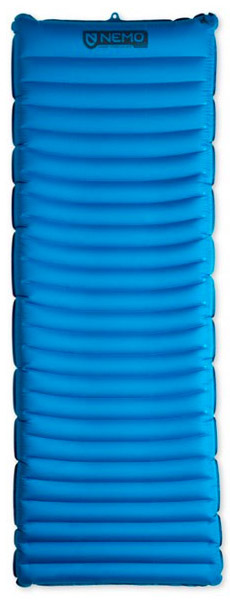 Type: Air mat
Type: Air mat
Dimensions: 76 x 25 x 3.5 in. (LW)
Weight: 2 lb. 1.0 oz.
R-value: 3.3
What we like: Impressively light and packable.
What we don’t: A step down in durability and comfort compared with self-inflating options.
Like the REI Kingdom above, Nemo's Quasar 3D is a pure air mat—there’s no foam to be found in its construction. This means that while it can’t quite match the comfort of self-inflating designs like the Therm-a-Rest MondoKing or Exped MegaMat, the Quasar has a major leg up in weight and packed size. For reference, it’s over 2 pounds lighter than the MondoKing and packs down to a fraction of the size, although you do sacrifice 1.25 inches of thickness and a good amount of insulation (the 3.3 R-value is on the low end for three-season use). That said, camping gear can get rather bulky and out of hand quickly, and those limited on space in their vehicle or gear closet will appreciate the compressibility.
However, there are some inherent trade-offs to shaving so much weight and bulk. Most notably, the Quasar has a fairly thin 30-denier shell (most camping mats on this list are 50D or higher), which will require added care to avoid a puncture. In addition, the Quasar isn’t very roomy for a camping mat—for reference, the “Long Wide” model listed here measures only 25 inches wide, which is on par with most brands’ standard versions (the regular Quasar is even narrower at 20 in.). But if you'd like something you can also take backpacking, the Nemo is one of the few viable crossover options for taking on short backcountry trips.
See the Nemo Quasar 3D
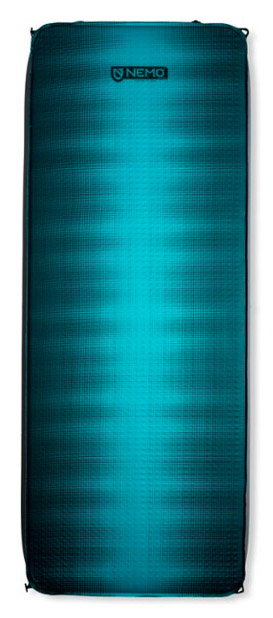 Type: Self-inflating mat
Type: Self-inflating mat
Dimensions: 78 x 30 x 4 in. (XL Wide)
Weight: 5 lb. 8.0 oz.
R-value: 6
What we like: Fantastic comfort yet surprisingly packable (for a self-inflating camping mat).
What we don’t: Expensive and slightly less plush-feeling than the MondoKing above.
In stark contrast to their lightweight Quasar air mat, Nemo's luxe Roamer puts a premium on all-out comfort and plushness. Made in Double and XL Wide versions (we’ve included the latter here), the Roamer goes head-to-head with premium designs like the Therm-a-Rest MondoKing above with a thick foam shape (4 in.), self-inflating build with dedicated valves for inflating and deflating, and a durable yet soft top fabric. Plus, you get a large and flat surface for sleeping, toggles to connect two Roamers together, and the use of recycled, bluesign-approved fabrics. The price is quite high, but at $250 for the XL Wide variation, it’s not far off from the aforementioned MondoKing ($240).
The Roamer recently saw a jump in our rankings due to its highly comfortable and luxurious feel—we took it out on a chilly fall camping trip in Washington state and were immediately struck by its well-cushioned and durable feel. It’s slightly less plush-feeling than the MondoKing and Exped’s MegaMat series, but the difference is very minor. And packed size is truly impressive: At just 10 x 16 inches, the Roamer easily undercuts both the MondoKing (10.3 x 26 in.) and single-person MegaMat 10 (9.8 x 31.3 in. for the regular wide model). This can make a significant difference for hauling in the back of a vehicle, especially for families and groups needing to bring along multiple mats and other bulky gear (tent, stove, chairs, cooler, etc.). You do pay a sizable premium for the improved compressibility and overall quality, but there’s a reason the Roamer is popular—it’s that good.
See the Nemo Roamer
 Type: Self-inflating mat
Type: Self-inflating mat
Dimensions: 72 x 25.6 x 3 in. (MW)
Weight: 4 lb. 8.3 oz.
R-value: 9
What we like: Vertical sidewalls and great comfort and warmth in an affordable package.
What we don’t: Doesn’t come with a pump or repair kit.
Exped is a leader in the camping mat market, and their DeepSleep line hits a nice balance of warmth, packability, and price. Like many of our other favorite self-inflating designs, including Exped’s own MegaMat, Nemo's Roamer, and Therm-a-Rest’s MondoKing above, the DeepSleep is comfortable with a thick foam build and vertical sidewalls, convenient with a self-inflating design and easily accessible inflate and deflate valves, and plush with a stretchy top fabric that’s both soft and fairly tough. And in terms of value, the DeepSleep comes in at a reasonable $170, which undercuts the aforementioned options by a considerable $70-$80.
However, the DeepSleep truly sets itself apart with its combination of warmth and packability. Stacked up against the similarly thick Therm-a-Rest LuxuryMap below, the Exped compresses noticeably smaller (26.5 x 8 in. for the DeepSleep vs. 26 x 9.5 for the large version of the Therm-a-Rest) while keeping you warmer in the process (it has a 9 R-value vs. 6 for the LuxuryMap). The Therm-a-Rest is 5 inches longer and a little lighter, but the Exped will save you a significant $40 while offering better all-around performance with its vertical sidewalls. For couples or those who prefer a double-wide model, the DeepSleep is also available in a Duo version for $270. And if you need more warmth (or a taller design) for the ultimate in camping luxury, check out Exped’s 6-inch-thick MegaMat Max 15 (R-value: 10.6).
See the Exped DeepSleep Mat 7.5
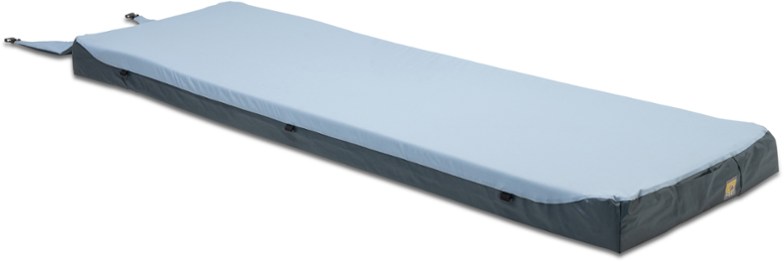 Type: Memory foam mat
Type: Memory foam mat
Dimensions: 78 x 25 x 3.9 in. (Regular)
Weight: 11 lb. 0 oz.
R-value: 8.8
What we like: Premium memory foam comfort in a camping-ready design.
What we don’t: Very large and bulky when packed; foam tends to harden in cold temperatures.
Hest is a relative newcomer to the world of sleep systems, but they’ve wasted no time in assembling a quality lineup of premium, ultra-comfortable pads. Our favorite this year is their Foamy Sleeping Pad, which combines two layers of thick and plush memory foam with a thoughtful array of camping-focused features. These include a nicely sized pocket for stashing a phone or keys, waterproof fabric along the bottom portion, deployable “welcome mat” for dirty shoes, and removable cover that’s machine-washable for easy cleaning. And perhaps the biggest draw: Compared to the self-inflating and air pad competition, the Foamy is a cinch to set up and pack away—just undo the buckles and let it expand when you get to camp, then roll it up and secure it with the strap-equipped compression harness when it’s time to leave.
Car camping can be a pretty involved undertaking, especially as a family or larger group, so we love gear that allows us to simplify and streamline the process. However, the trade-off is that the Hest Foamy is noticeably large and bulky when rolled up (it measures around 15 in. in diameter when secured with the straps). While testing the Foamy in Utah, we also noticed the foam had a tendency to harden and lose some of its cushiness when temperatures dipped into the low to mid 30s Fahrenheit (although the 8.8 R-value is plenty for year-round use). But that experience did little to dampen our enthusiasm for the Foamy: As long as you’ve got the space, it’s one of the most comfortable options here and by far the easiest to use. For an even thicker, warmer, and plusher option from Hest with an inflatable base, see their upgraded Sleep System below.
See the Hest Foamy Sleeping Pad
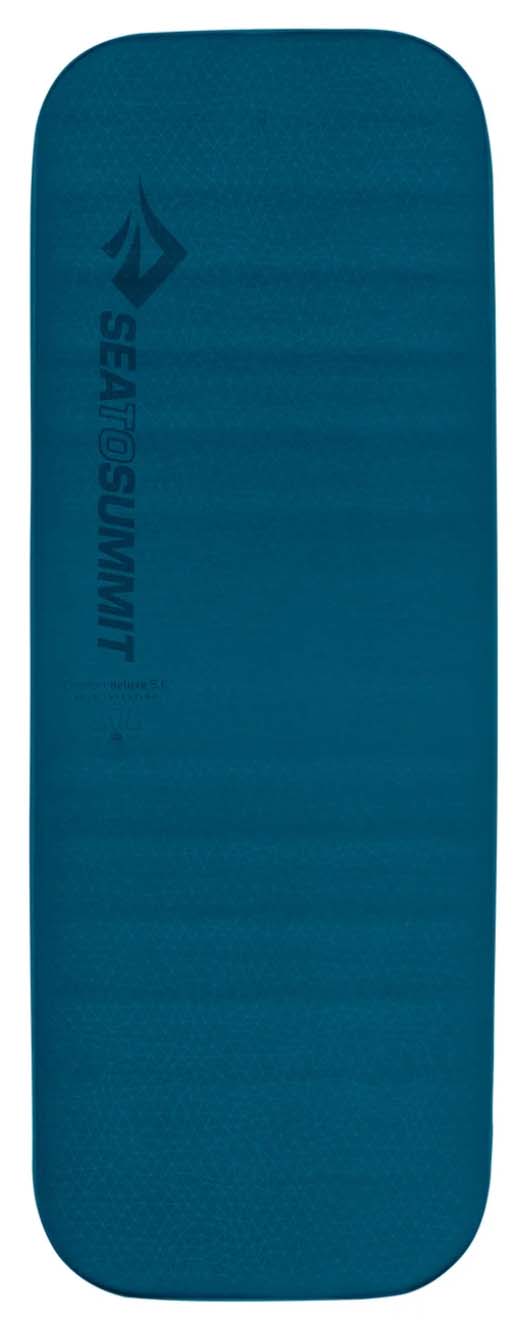 Type: Self-inflating mat
Type: Self-inflating mat
Dimensions: 72 x 25 x 4 in. (Regular Wide)
Weight: 4 lb. 6.0 oz.
R-value: 6.5
What we like: Great mix of thickness, comfort, and weight.
What we don’t: Not a standout in any one category.
Self-inflating camping mats are a dime a dozen, but there’s certainly something to be said for a quality all-rounder like Sea to Summit’s Comfort Deluxe SI. With a plush 4-inch-thick build and R-value of 6.5, it’s competitive with premium alternatives like the Therm-a-Rest MondoKing 3D (4.25 in; R-value: 7) and Nemo Roamer (4 in.; R-value: 6) both in warmth and overall comfort. The Comfort Deluxe used to undercut both in price by $20-$30, but a recent price hike now puts it in the same ballpark. However, the Comfort Deluxe is over a pound lighter than the Roamer (it's identical to the MondoKing). Added up, it’s a very well-rounded design that effectively balances cushioning, comfort, and weight.
Why do we have the Sea to Summit Comfort Deluxe SI ranked here? Put simply, it’s hard to stand out in such a competitive market. The aforementioned MondoKing gets the slight edge in thickness and warmth, and it's longer and wider to boot. Alternatively, Exped’s DeepSleep Mat 7.5 above costs a whopping $80 less and has a higher R-value of 9, although it’s a little less cushioned at 3 inches thick. A final option to weigh is Therm-a-Rest’s LuxuryMap below, which is longer by 5 inches (for the large size) and will save you around $40, although the Sea to Summit is an inch thicker, packs down smaller, and is slightly warmer. In the end, all are quality options from reputable outdoor brands, and a final decision will come down to what you prioritize most as a camper.
See the Sea to Summit Comfort Deluxe SI
 Type: Self-inflating mat
Type: Self-inflating mat
Dimensions: 72 x 25 x 1.5 in. (Regular Wide)
Weight: 3 lb. 0 oz.
R-value: 5.5
What we like: Cheaper and warmer than the Sea to Summit Camp SI above.
What we don’t: Also heavier and considerably bulkier.
REI’s latest sleeping pad, the Trailmade, goes head-to-head with Sea to Summit’s Camp SI above as a competitive budget design for easy-to-please campers. We’ll start with the positives: For a very palatable $85, the Trailmade is warmer with an R-value of 5.5 (the Sea to Summit is 4.2), boasts a soft fabric on top for improved comfort, and checks in at a very reasonable 3 pounds. The 2-pound-7-ounce Camp SI is the better option for occasionally bringing into the backcountry, but the REI will get the job done in a pinch. And we applaud REI for continuing to prioritize sustainability by using recycled polyester for the bottom of the pad. Taken together, it’s a no-frills but competitively priced option for campers who don’t demand a lot out of their sleeping pad.
Now for the downsides: First, while only slightly heavier than the Camp SI, the Trailmade is significantly bulkier when packed down into its stuff sack (7 x 26.9 in. for the Regular Wide size compared to 8 x 13.5 in. for the Sea to Summit with identical dimensions). This isn’t unheard of among self-inflating mats—air mats get the clear edge in compressibility—but seems extreme given the Trailmade’s 1.5-inch thickness. Speaking of cushioning, back sleepers and those who prioritize price over comfort may not mind the lack of padding, but side sleepers and campers looking for a home-away-from-home experience will want to steer clear. In the end, the Trailmade’s drawbacks are enough to push it lower on our list, but it’s decently warm and well built for the price.
See the REI Co-op Trailmade
 Type: Self-inflating mat
Type: Self-inflating mat
Dimensions: 78 x 25 x 7 in.
Weight: 26 lb. 0 oz.
R-value: 11.8
What we like: Fully featured, durable, and the highest R-value on our list.
What we don’t: The heaviest and most expensive option here.
Mixing premium materials and an innovative multi-layer design, Hest's Sleep System is a far cry from the traditional self-inflating options above. Starting with the foam portion of the mat, you essentially get two pads in one: The top layer is an open-cell foam that nicely conforms to your body, while the bottom layer is a denser blend for added support and cushioning from the ground (or a truck bed). Below this is an inflatable yet very durable base that provides a solid structure and additional height. The net result is impressive comfort and warmth—in fact, this is among the most heavily cushioned and insulated designs on our list at 7 inches thick and with an R-value of 11.8.
Unfortunately, however, there are a couple of glaring downsides to this lavish setup. At $449 and a whopping 26 pounds, the Hest Sleep System is incredibly pricey and will be a pain to store and lug from car to campsite, even if you’re sleeping close to your vehicle. Hest does include a functional storage bag with handy compression straps, but the packed size is still very large and bulky. If you don’t need the winter-ready warmth, Hest's Foamy Sleeping Pad above will save you a considerable $150 and around 15 pounds, and even Exped’s MegaMat Duo 10 above is cheaper at $400 (and can fit an additional person). But if you get out frequently and plan to utilize the warmth and features, the Hest Sleep System won’t disappoint. For couples and vehicle-based campers who like to sprawl out, the two-person Dually is similarly well built and premium (and made in a dedicated Roof Top Tent version).
See the Hest Sleep System Sleeping Pad
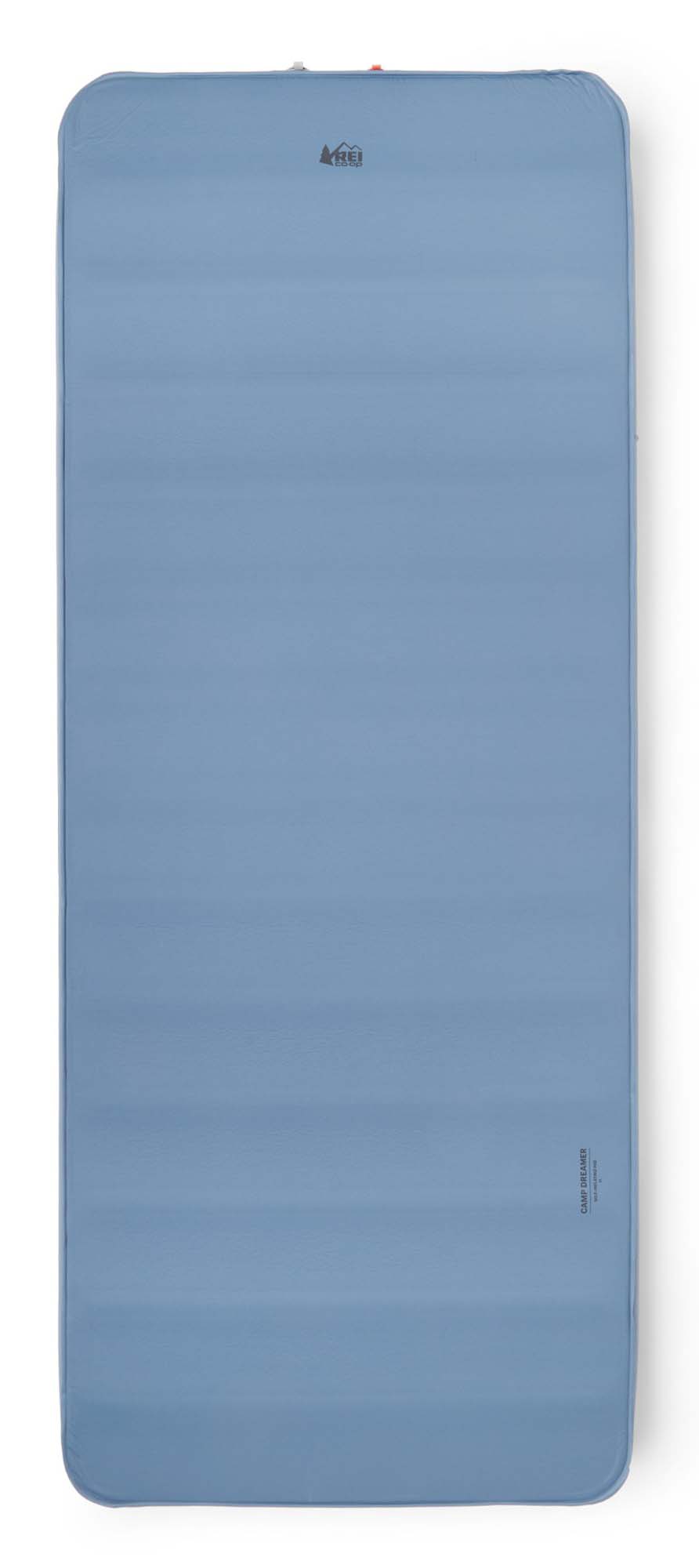 Type: Self-inflating mat
Type: Self-inflating mat
Dimensions: 78 x 32 x 4 in.
Weight: 6 lb. 6.0 oz.
R-value: 6.6
What we like: Spacious, comfortable, and reasonably priced for what you get.
What we don’t: Wide and bulky; valve is leak-prone.
Car camping really allows you to step up your sleeping comfort, and the REI Camp Dreamer XL is a case in point. This mattress is very spacious at a healthy 32 inches wide, super comfortable with 4 inches of cushioning off the ground, and warm enough for most 3-season conditions with an R-Value of 6.6. And at $179, the Camp Dreamer is a significant $61 cheaper than the Therm-a-Rest MondoKing 3D above and 7 inches wider to boot. For those who want camping luxury that can rival sleeping at home, the REI Camp Dreamer XL is an excellent choice.
What are the shortcomings of the Camp Dreamer? For starters, it's a large mat that takes up a healthy amount of space, even when packed down, and it's heavy at over 6 pounds. In addition, some might find that the generous size is too much—many camping mats on this list are around 25 inches in width, which should be sufficient unless you frequently toss and turn. Last but not least, there have been a good number of leak- and durability-related complaints, which make the REI less of a standout than the MondoKing, DeepSleep, and Comfort Deluxe SI above. To be clear, we think the Camp Dreamer is a good value for what you get, but committed campers and those who are hard on their gear will likely want to spend up for the Therm-a-Rest, Exped, or Sea to Summit.
See the REI Co-op Camp Dreamer XL
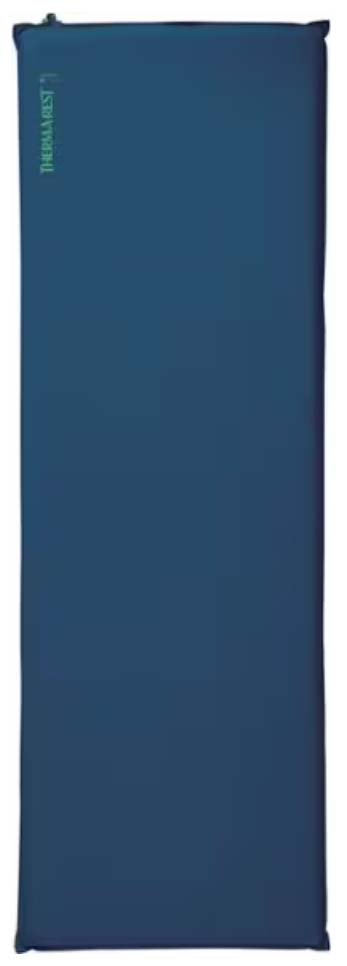 Type: Self-inflating mat
Type: Self-inflating mat
Dimensions: 72 x 20 x 2 in. (Regular)
Weight: 2 lb. 8.0 oz.
R-value: 6
What we like: Competitively light and well rounded for the price.
What we don’t: The narrowest design on our list and only 2 inches thick.
The second Therm-a-Rest design to make our list, the BaseCamp features a well-rounded self-inflating design at a good value. Highlights include a soft and durable exterior, a four-season-ready R-value of 6, and Therm-a-Rest’s trusty WingLock valve for quick and easy inflation and deflation. At 2 pounds 8 ounces and just 7 by 21 inches when packed into its stuff sack, the BaseCamp is also competitively light and compact, making it a viable option for crossing over into backpacking. Finally, at $115, this mattress is very affordably priced for what you get.
The BaseCamp hits a desirable middle ground for many campers: It offers a boost in cushioning compared to true budget designs like the Sea to Summit Camp SI and REI Trailmade above while considerably undercutting premium alternatives like Therm-a-Rest’s own MondoKing. That said, you only get a single valve for inflation/deflation, and comfort-conscious campers will likely want to step up to the 77- by 25-inch large version for $20 more. We’ve included the regular size here because of its crossover appeal (the large is heavy for backpacking at 3 lb. 6 oz.), but the $135 large is still a good value for what you get. For a step up in cushioning and features, check out Therm-a-Rest’s upgraded LuxuryMap below.
See the Therm-a-Rest BaseCamp
 Type: Air mat
Type: Air mat
Dimensions: 77.6 x 25.6 x 3.5 in. (LW)
Weight: 2 lb. 11.6 oz.
R-value: 7.8
What we like: Extremely warm but still packs down small.
What we don’t: Overkill for most three-season camping trips.
Exped’s Dura 8R—a replacement to their DownMat collection—fills a unique niche with its winter-ready air pad construction. Like the outgoing DownMat, the Dura is packable and highly insulated thanks to the 700-fill goose down that is bonded to the interior. It’s also been built to withstand the rigors of cold-weather use with a tough ripstop polyester shell that’s made with thick (75 and 170D) fabrics and laminate along the inside for fending off bacteria and moisture. For situations where warmth and packed size are priorities—such as setting up basecamp on a mountaineering or ski touring trip—the Dura 8R is hard to beat.
However, like the DownMat, the latest Dura 8R ends up near the bottom of our list because of its narrow appeal: Most will leave it behind on three-season camping adventures, and at 2 pounds 11.6 ounces, it's not the lightest option available for mixing in the occasional backpacking trip. Exped does make lighter and cheaper versions of the Dura, the 3R and 5R, but both of those pads use synthetic rather than down fill, offer considerably less warmth, and are half an inch thinner. Another cold-weather standout to have on your radar is Therm-a-Rest's NeoAir XTherm NXT Max, which offers comparable warmth with a 7.3 R-value and checks in at just 1 pound 7 ounces (it’s the better backpacking companion) but is shorter by 5.6 inches, thinner by 0.5 inches, and costs $20 more.
See the Exped Dura 8R
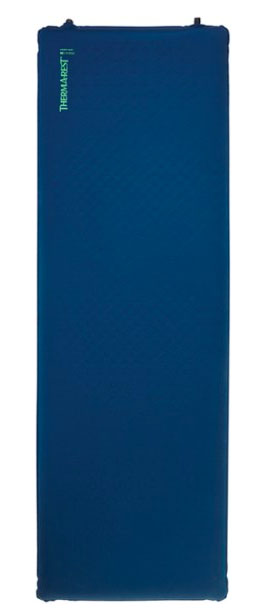 Type: Self-inflating mat
Type: Self-inflating mat
Dimensions: 77 x 25 x 3 in. (L)
Weight: 4 lb. 3.0 oz.
R-value: 6
What we like: Checks all the boxes for most campers, including decent thickness, good durability, and easy-to-use valves.
What we don’t: Not a strong value.
The LuxuryMap from Therm-a-Rest is another solid self-inflating camping mat. Like their Basecamp above, the LuxuryMap features supple but tear-resistant materials, separate inflation and deflation valves, and Therm-a-Rest’s typical build quality. You also get 3 inches of their supportive foam cushioning, which is an inch more than the BaseCamp. To be sure, it can’t compete with truly luxurious options like Therm-a-Rest’s own MondoKing or the Exped MegaMat above, but the LuxuryMap’s durable, soft lining and easy-to-use twist valves get the job done for most camping adventures.
Within the Therm-a-Rest lineup, the LuxuryMap is a decent value, but we think there are better options on the market. For example, Exped’s DeepSleep Mat above is also 3 inches thick but slightly wider and much warmer with an R-value of 9—all for $40 less. Budget-minded shoppers should also keep Therm-a-Rest’s own BaseCamp in mind, which costs $115 for the regular size ($135 for the comparable large model) but has a thinner 2-inch construction and just one valve. And a final point worth noting: Some users report that the LuxuryMap feels narrower than its advertised width due to the pad’s sloped (rather than vertical) sidewalls.
See the Therm-a-Rest LuxuryMap
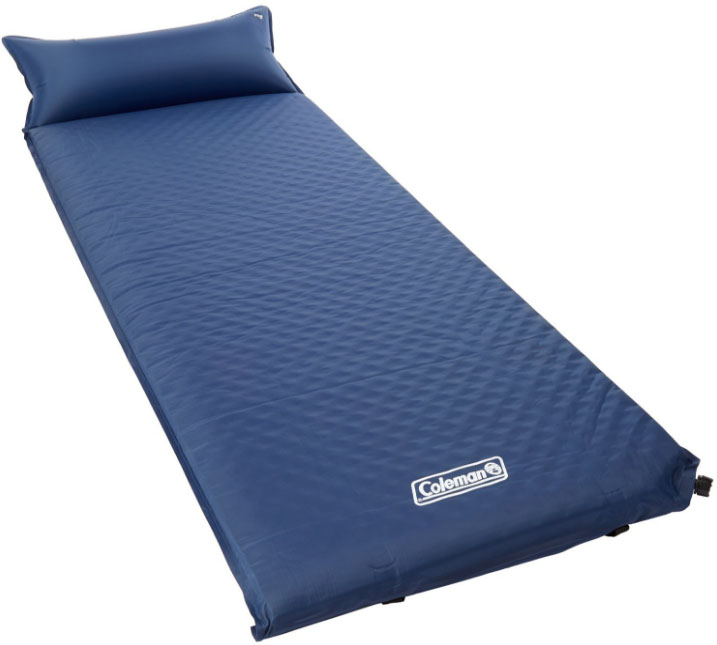 Type: Self-inflating mat
Type: Self-inflating mat
Dimensions: 76 x 25 x 2.5 in.
Weight: 4 lb. 8.0 oz.
What we like: Cheap, decently comfortable, and durable.
What we don’t: Slippery top fabric, less comfortable than the pads above.
For casual campers who only sleep outside once or twice a summer, the Coleman Self-Inflating Sleeping Pad is a durable and very affordable option. At $60 full price and consistently available on Amazon for less, you get self-inflating construction, foam padding, and even a built-in pillow. We didn’t find the pillow very comfortable (it doesn’t have any foam inside, and the nylon exterior isn’t soft by any means), but it’s nice to have in case you leave yours at home. Further, the 76- by 25-inch sleeping space rivals that of the large-size pads above and is plenty roomy for spreading out.
Overall comfort is where the Coleman falls short of even the budget-oriented Sea to Summit Camp SI and REI Trailmade above, which will run you around $20-$30 more. The biggest culprit is the plasticky finish on the shell, which makes it slippery and prone to trapping sweat on hot summer nights. As such, we’d lean toward spending up for the Camp or Trailmade in most cases, but the Coleman is the clear cost leader and still far plusher than your old 0.5-inch foam pad.
See the Coleman Self-Inflating Sleeping Pad
| Mattress | Price | Type | Dimensions | Weight | Packed Size | R-Value |
|---|---|---|---|---|---|---|
| Therm-a-Rest MondoKing | $240 | Self-inflating | 77 x 25 x 4.25 in. | 4 lb. 6.0 oz. | 10.3 x 26 in. | 7 |
| Exped MegaMat Duo 10 | $400 | Self-inflating | 77.6 x 52 x 4 in. | 9 lb. 14.7 oz. | 11.8 x 27.6 in. | 8.1 |
| Sea to Summit Camp SI | $89 | Self-inflating | 72 x 25 x 1.5 in. | 2 lb. 7.0 oz. | 8 x 13.5 in. | 4.2 |
| REI Kingdom Insulated | $149 | Air bed | 79 x 56 x 6.0 in. | 5 lb. 13.0 oz. | 10 x 20 in. | 2.6 |
| Nemo Quasar 3D | $200 | Air mat | 76 x 25 x 3.5 in. | 2 lb. 1.0 oz. | 5.5 x 9 in. | 3.3 |
| Nemo Roamer | $250 | Self-inflating | 78 x 30 x 4.0 in. | 5 lb. 8.0 oz. | 10 x 16 in. | 6 |
| Exped DeepSleep Mat 7.5 | $170 | Self-inflating | 72 x 25.6 x 3.0 in. | 4 lb. 8.3 oz. | 8 x 26.5 in. | 9 |
| Hest Foamy Sleeping Pad | $299 | Memory foam | 78 x 25 x 3.9 in. | 11 lb. 0 oz. | 26 x 14 x 13 in. | 8.8 |
| S2S Comfort Deluxe | $249 | Self-inflating | 72 x 25 x 4 in. | 4 lb. 6.0 oz. | 7.5 x 25 in. | 6.5 |
| REI Co-op Trailmade | $85 | Self-inflating | 72 x 25 x 1.5 in. | 3 lb. 0 oz. | 7 x 26.9 in. | 5.5 |
| Hest Sleep System | $449 | Self-inflating | 78 x 25 x 7 in. | 26 lb. 0 oz. | 14 x 25 in. | 11.8 |
| REI Camp Dreamer XL | $179 | Self-inflating | 78 x 32 x 4 in. | 6 lb. 6.0 oz. | 11 x 30 in. | 6.6 |
| Therm-a-Rest BaseCamp | $115 | Self-inflating | 72 x 20 x 2 in. | 2 lb. 8.0 oz. | 7 x 21 in. | 6 |
| Exped Dura 8R | $250 | Air mat | 78 x 26 x 3.5 in. | 2 lb. 11.6 oz. | 13.8 x 6.7 in. | 7.8 |
| Therm-a-Rest LuxuryMap | $210 | Self-inflating | 77 x 25 x 3 in. | 4 lb. 3.0 oz. | 9.5 x 26 in. | 6 |
| Coleman SI Pad w/ Pillow | $60 | Self-inflating | 76 x 25 x 2.5 in. | 4 lb. 8.0 oz. | 8 x 26 in. | Unavail. |
The Switchback Travel crew started testing camping mattresses for this review back in 2021. Spearheaded by former editor-in-chief John Ellings and managing editor Sarah Nelson, the lineup consists of everything from thick, plush options for car camping to sleeker and lighter contenders that can pull double duty for shorter backpacking trips (though we also have a dedicated review for backpacking sleeping pads). Both John and Sarah have spent hundreds of nights sleeping in the great outdoors, from remote glaciers in Patagonia to their vehicles just outside of town. They understand the importance of balancing comfort with the best features, packed size, and price for your intended adventure(s).
Current editor-in-chief Penney Garrett now manages this guide and also brings decades of camping experience to the table. Every time she and the team research new options, multiple factors are considered. Thickness is a key component for comfort, but warmth, or R-value, can't be understated. The presence (or lack thereof) and quality of insulation can go a long way to helping someone have a restful night's sleep over shivering the night away above a balloon of cold air. Shape, width, sidewall design, and the inflation/deflation process are other factors to consider for the best overall experience. Rest assured, as the market changes and improves, we work to update and adapt this guide on a regular schedule.
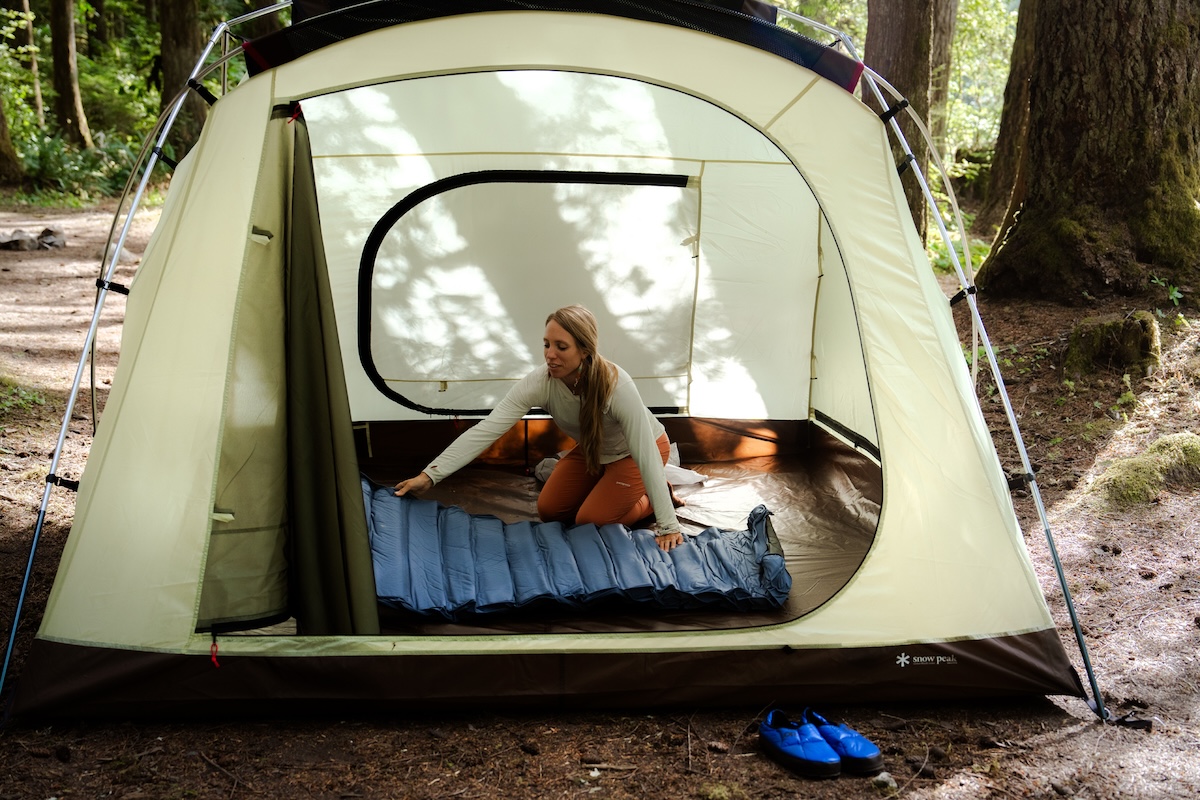
Self-Inflating Mats
Therm-a-Rest released the first self-inflating mattress in the early 1970s, and the same basic design has soldiered on for years. The interior of these mattresses is filled with an open-cell foam that expands and fills with air when you open the valve (hence the name "self-inflating"). In comparison to pure air mattresses, a self-inflating mat has a cushier feel thanks to the foam, although it doesn’t compress as small and is heavier. For camping, when comfort is more important than weight and packed size, self-inflating mattresses are our favorites. It's no coincidence that the plush Therm-a-Rest MondoKing 3D tops our list.
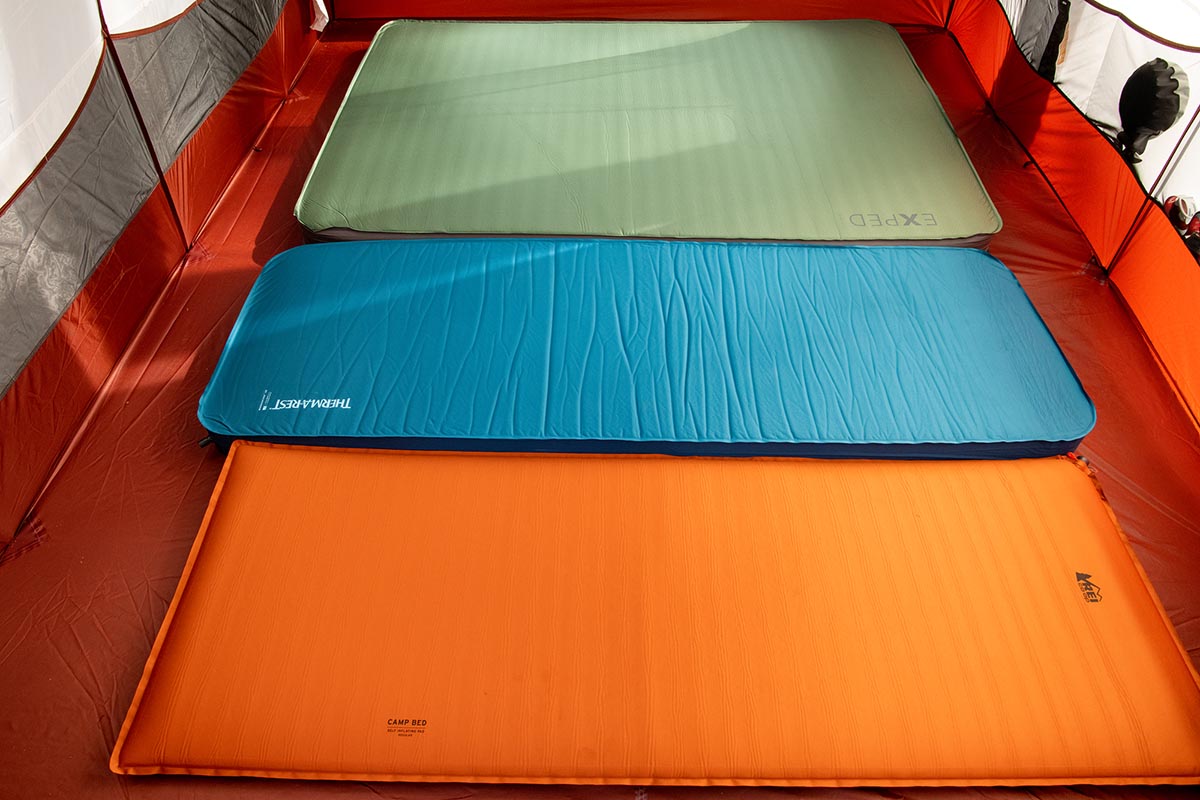
Air Mattresses
As the name implies, an air mattress is filled almost entirely with air. Inflating these mats requires you to either blow air through a valve or use a pump. What you gain is weight savings: At a given thickness, an air mat might weigh half or even less than a comparable self-inflating mattress. Moreover, air mattresses are the most compressible pad option. Even insulated models with synthetic or down-fill bonded to the interior can be rolled into a compact size, which makes storage and transport very easy. This is great for backpacking, but overall comfort does fall short compared with a self-inflating pad. Air mats lack the squishy and supportive feel that you get with foam. If this sounds like the right route for you, we love the Nemo Quasar 3D (on our list above) and the Therm-a-Rest NeoAir XLite NXT (the top pick in our backpacking-specific review).
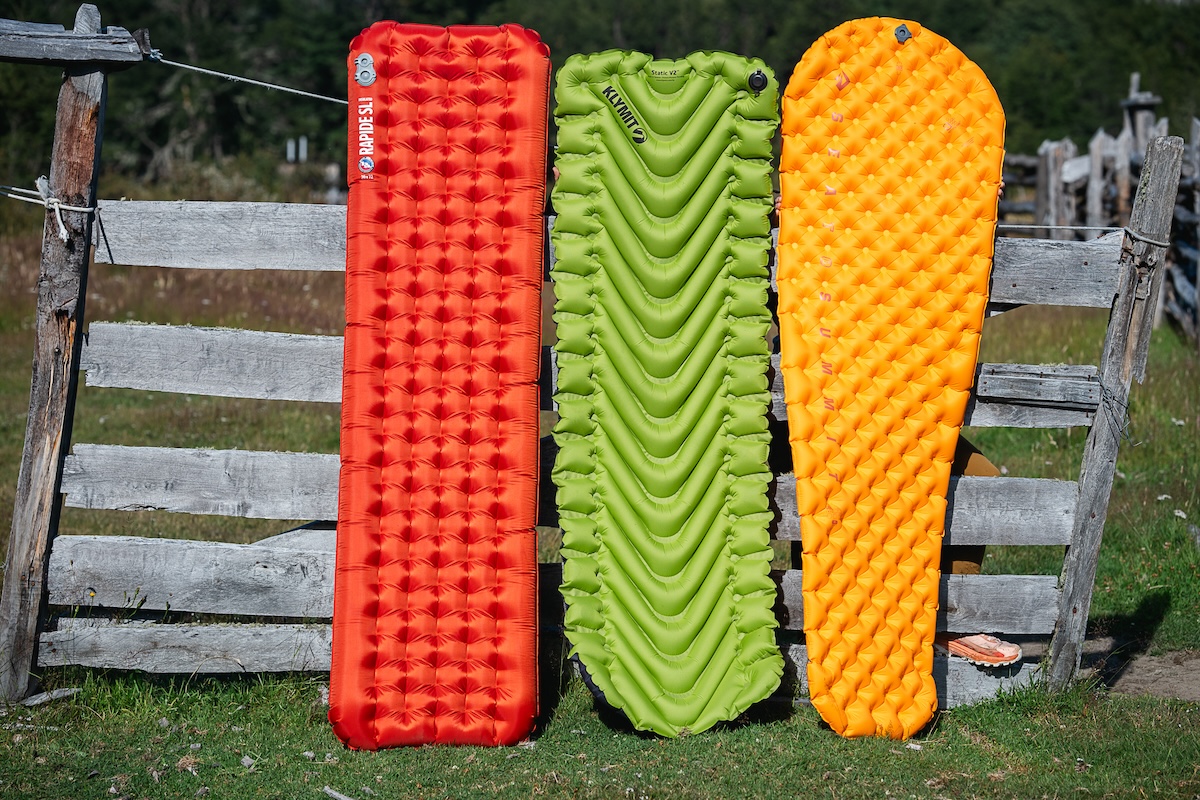
Foam Pads
Your classic sleeping mat is made of closed-cell foam. These pads don’t require any inflating to set up—just unroll it and you’re done. The big upside is there’s no risk of getting a puncture, but closed-cell foam is by far and away the least comfortable mattress type (there's a reason that none made our list above). They are very thin (less than 1 inch vs. 2 inches or more for a self-inflating or air mat), so they can’t disguise bumps in the ground beneath you. But if you’re the type that can comfortably crash on a friend’s floor—and we mean directly on the floor—save yourself some coin and get a foam pad like the Therm-a-Rest RidgeRest or Nemo Switchback. These pads will only set you back around $30-60 (the Nemo is thicker and also more expensive) and offer all the comfort a low maintenance camper requires. If you like more comfort, however, one of the other pads from our list above will suit you much better.
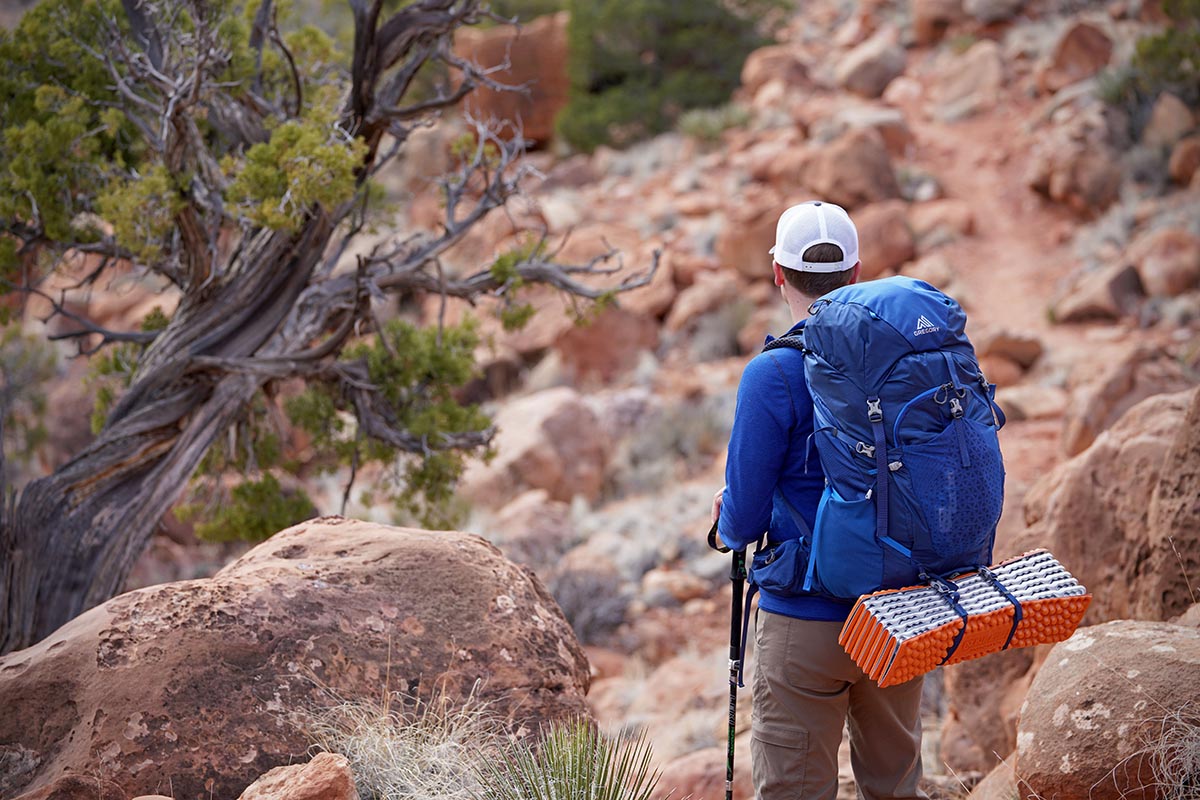
With plenty of sleeping space in your camping tent, you may have the luxury to decide between a traditional sleeping mattress or a full-on blow up air bed. So which one should you choose? The main benefit of an air bed is it gets you farther off the ground for easier up and down (a cot can do the same). Further, the large size is great for couples, families, or if you just like to spread out. And if you’re trying to save some dough, air beds are friendlier for use at home for guests, especially if you choose a two-person queen-sized option. In terms of comfort, however, we give the standard sleeping mat the upside, particularly those that have foam in the construction.

A cot may stretch the definition of a sleeping mattress—which is why we haven't included any on our list above—but it’s a viable and popular way of sleeping in a tent. Many people like cots because there's no risk of deflation, the sturdy metal structure gets you off the ground, and they can also double as a couch for hanging out during the day. Comfort-wise, they usually fall in the mid-range, although you can always add a mat overtop.
The most important consideration is whether you can transport the cot and fit it inside your tent. Most cots only fold in half, so they are extremely large. If you’re bringing a few cots, it may be impossible to squeeze everything into your vehicle. And inside your tent, the tall height of the cot may run into the sloped walls. But if you have the space and are willing to haul it around, a cot can be a great choice for camping. Some of our favorite options are Coleman’s ComfortSmart Deluxe, REI’s Kingdom Cot 3, and Mountain Summit Gear’s Horizon Cot.
In the same way buying your mattress at home is a personal decision, not everyone will agree on which camping mattress type is best. The good news is that most quality mattresses are in fact quite comfortable. We give the edge to self-inflating pads for the cushy but supportive foam that makes them a little more comfortable, but back sleepers, side sleepers, and even stomach sleepers should be happy with most of the models that made our list.
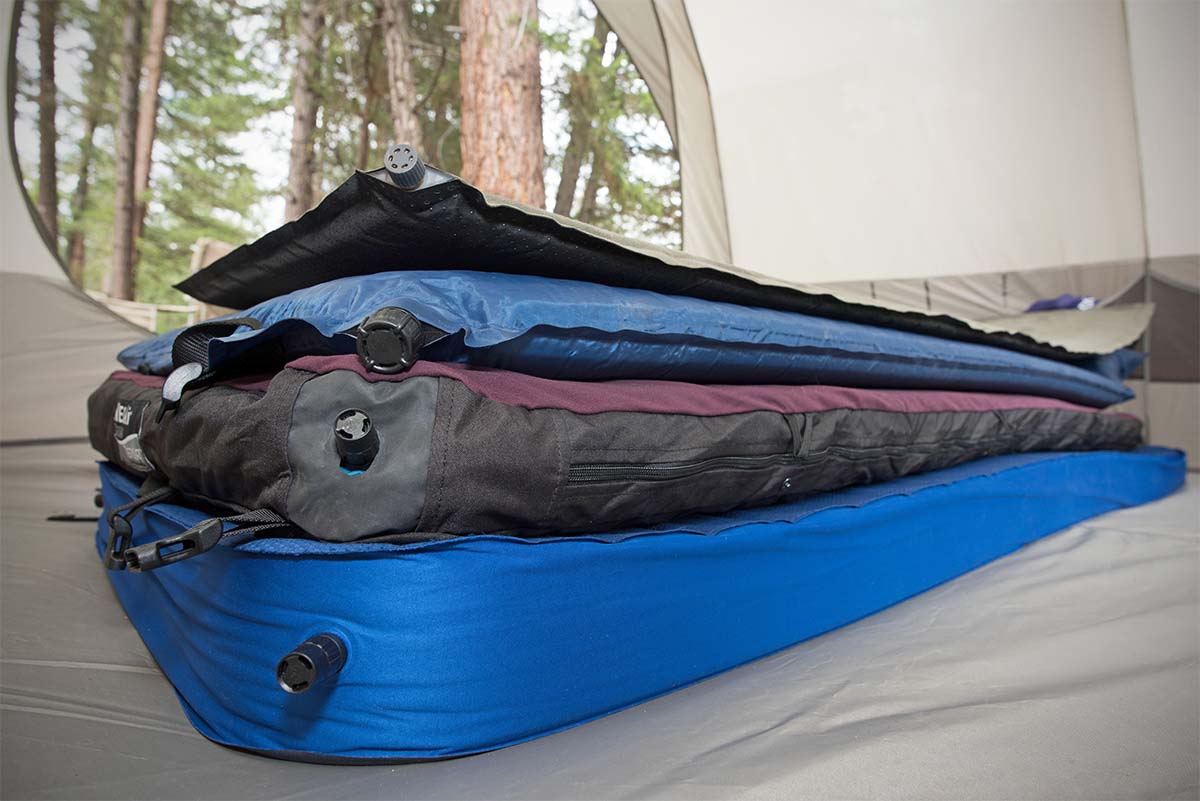
For some general guidelines regarding pad thickness, side sleeping puts a higher percentage of weight around the hips and shoulders, so a pad or air bed that’s 3 inches thick or more is advisable. Back sleepers—depending on personal preferences—can get away with a thinner pad. And if you're a finicky sleeper, it's not a bad idea to upgrade to a premium pad like the 4.25-inch thick Therm-a-Rest MondoKing. It's true that tolerant sleepers can deal with less, but if you camp out a lot, it's often worth the investment.
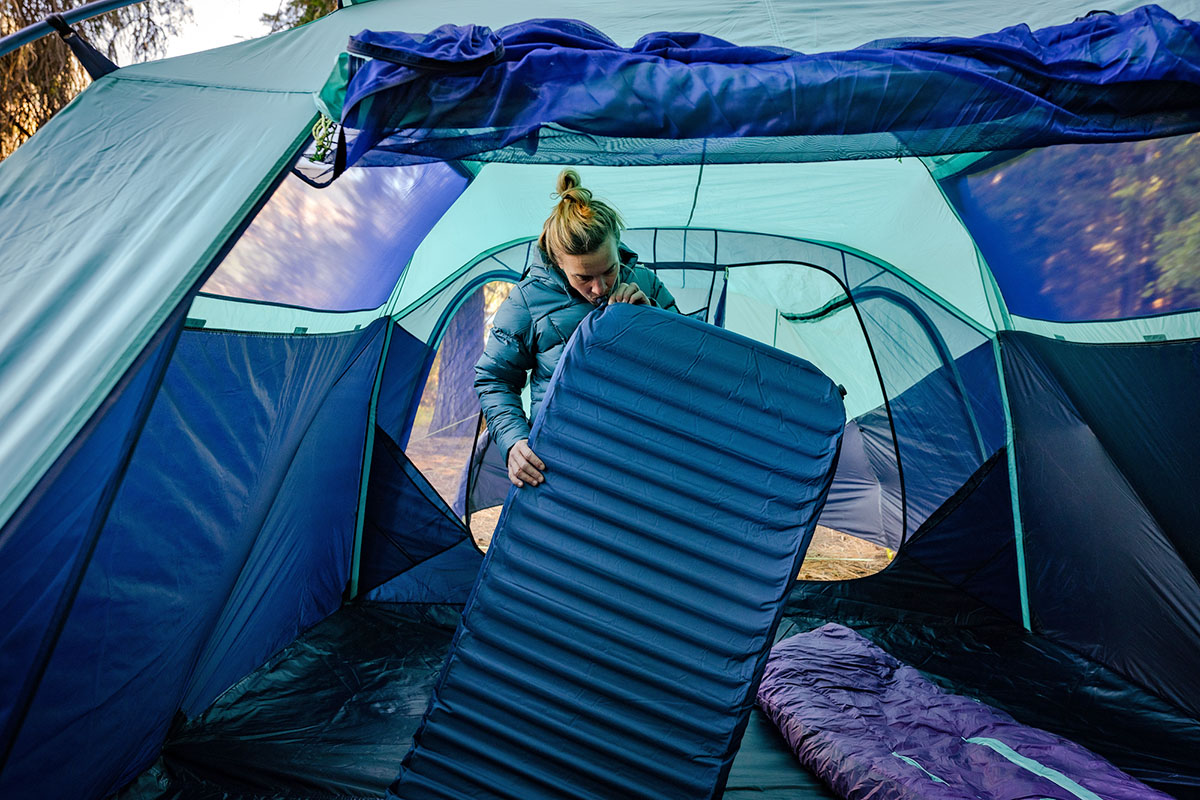
In addition to thickness, sidewall design can also have a sizable impact on sleeping comfort. This is a pretty key differentiator between budget/mid-range self-inflating pads and high-end designs: In general, you can expect cheaper pads to taper and slope downward along the sides, while many premium models boast vertical sidewalls that allow you to enjoy the entire, flat platform. Standouts in the latter category include the Therm-a-Rest MondoKing 3D, Nemo Roamer, and Exped’s DeepSleep and MegaMat collections. Combined with their generous cushioning, these pads offer excellent all-around comfort and will feel the most like your mattress at home. By comparison, tapered sidewalls—what you get with many budget designs like the Sea to Summit Camp SI—eat into the amount of usable space, meaning you’re getting a little less length and width than the specs suggest.
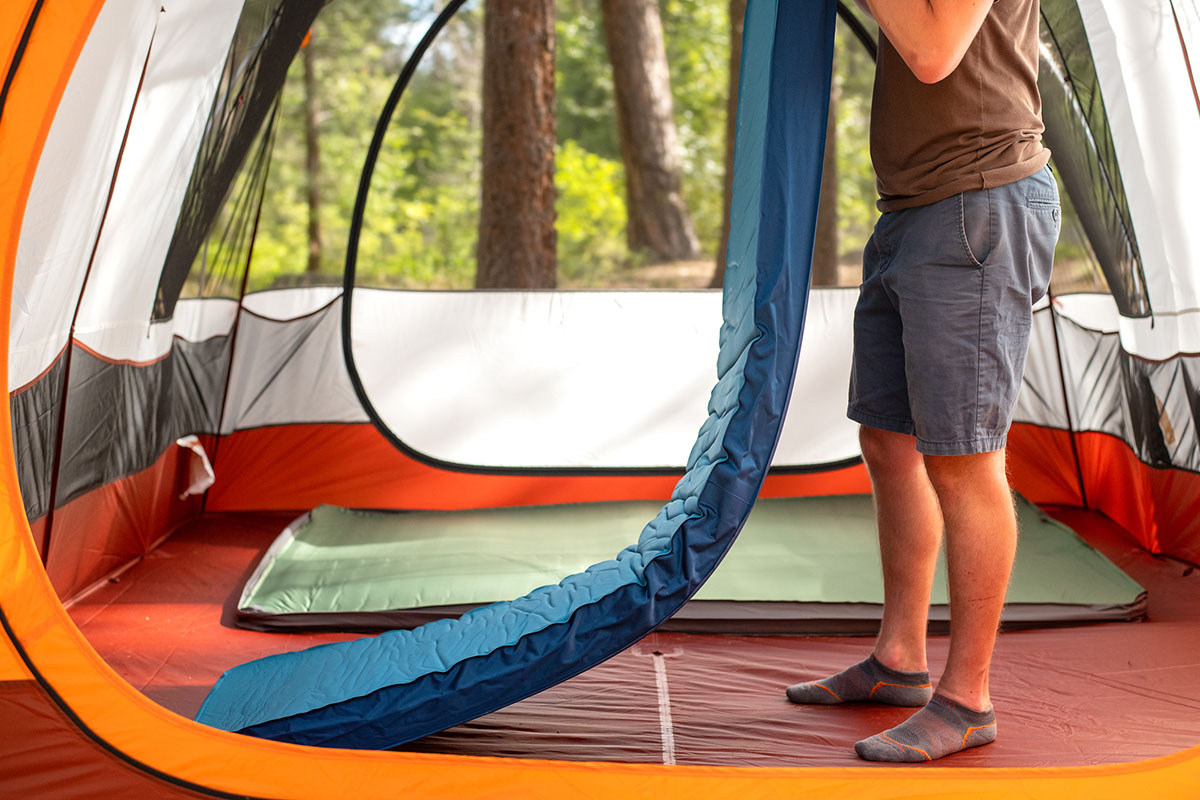
In the spirit of comfort, camping pads and mattresses have a much larger footprint than their backpacking cousins. Some are offered in the smaller 72-inch length, but many start at approximately 77 inches and extend to 80 to 85 inches (the XXL version of the Therm-a-Rest MondoKing 3D is 80 x 30 inches). The longer length is great for taller folks, but just about everyone can appreciate the extra width. 20-inch pads are standard fare for backpacking and usually mean at least one arm is sliding off the pad during the night. The 25 or 30-inch widths you get with a camping pad (extending as wide as 60 in. for a queen-size air bed) are a welcome relief and can make a real difference in nighttime comfort. Active sleepers who roll around in their sleeping bag will also appreciate the additional space.
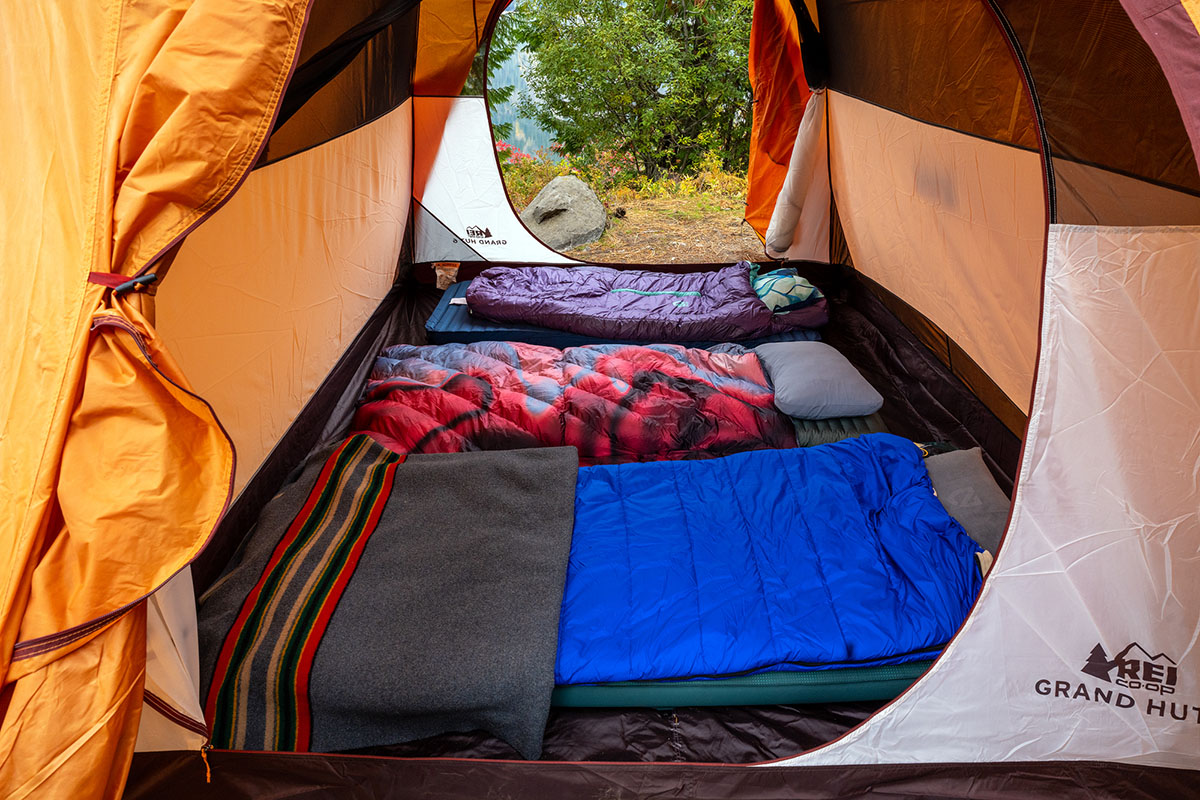
A camping mattress’ ability to insulate you from the cold ground is measured in R-value, and a higher number indicates better protection. Not all manufacturers provide the spec, but it's a helpful tool when available. In the heat of summer—especially at lower elevations—you can get away with almost no insulation in most cases (an R-value in the 1-3 range should suffice). For three-season use, we recommend getting a pad with at least an R-value of 3. If you’ll be out in the winter, potentially sleeping on top of snow, get a mattress with a rating above 5. And for these conditions, it’s often a good idea to combine your inflatable mattress with a foam pad, not only for a boost in insulation, but also a level of security should your inflatable pad spring a leak.
Camping is typically a drive up and unload kind of activity, so the weight and packed size of your gear isn’t always the number one consideration. And in choosing your camping gear, it’s almost always worth taking the more comfortable and durable route rather than the lightest or most compressible. That said, if you don’t have a whole lot of extra space in your rig (or home for long-term storage), it’s worth checking the specs before buying a massive camp bed. For example, the Hest Sleep System Sleeping Pad measures 14 x 25 inches and weighs a whopping 26 pounds. At the other end of the spectrum are crossover car camping and backpacking options like Nemo's Quasar 3D (2 lb. 1 oz. with a 9 x 5.5-in. packed size) and Sea to Summit's Camp SI (2 lb. 7 oz. and 8 x 13.5 in. for the Rectangular Wide model). The sweet spot for comfort, durability, and practicality is somewhere in between for most campers.
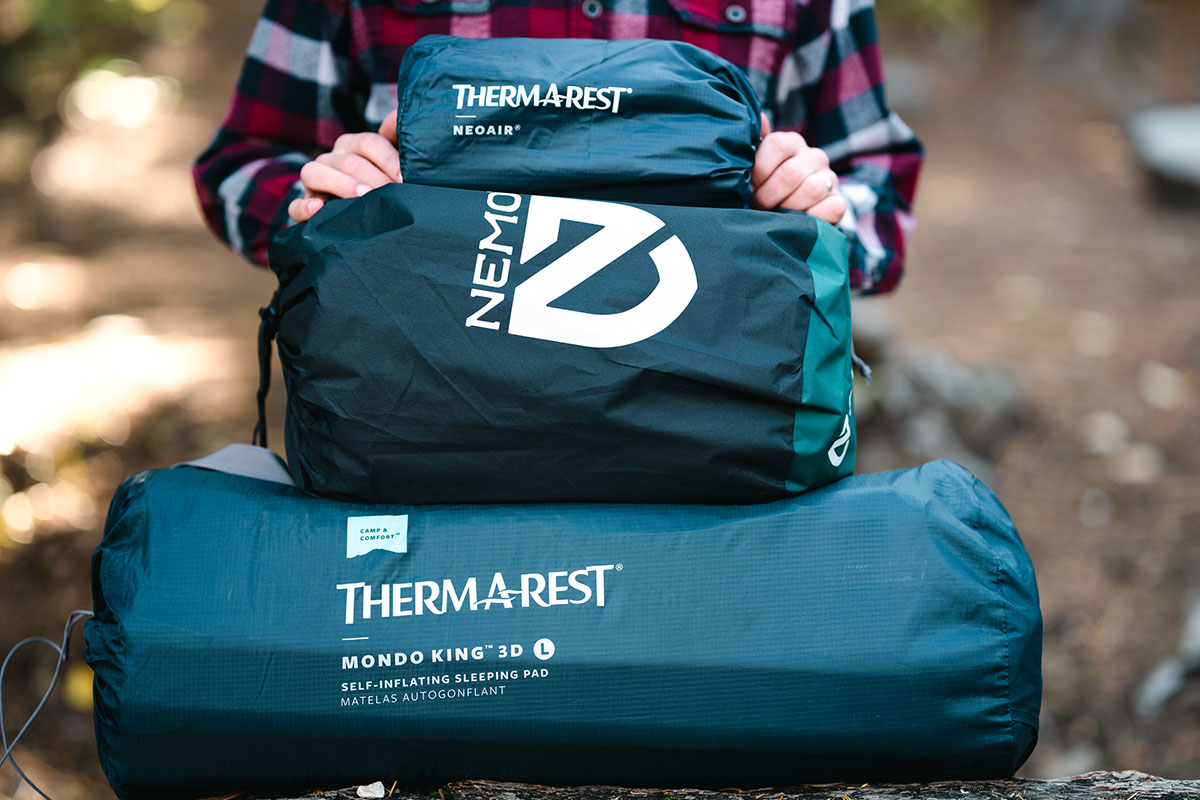
With weight out of the equation, most camping mattresses are very durable. Their thick fabrics are far less likely to get a puncture or spring a leak than a backpacking model, which is nice if you plan to sleep outside without a tent or have kids and/or dogs. There are, however, still differences between models, which is why we suggest checking the denier ratings (if available). For camping mats, denier ranges from about 50D to 150D (the Nemo Quasar is one exception with a thin 30D shell), with the higher numbers offering greater tear and puncture resistance. The underside of a pad often gets the most abuse, so it’s a good idea to look into that thickness in particular. And finally, material quality matters, so you can expect a pricier option of a similar denier to provide superior durability.
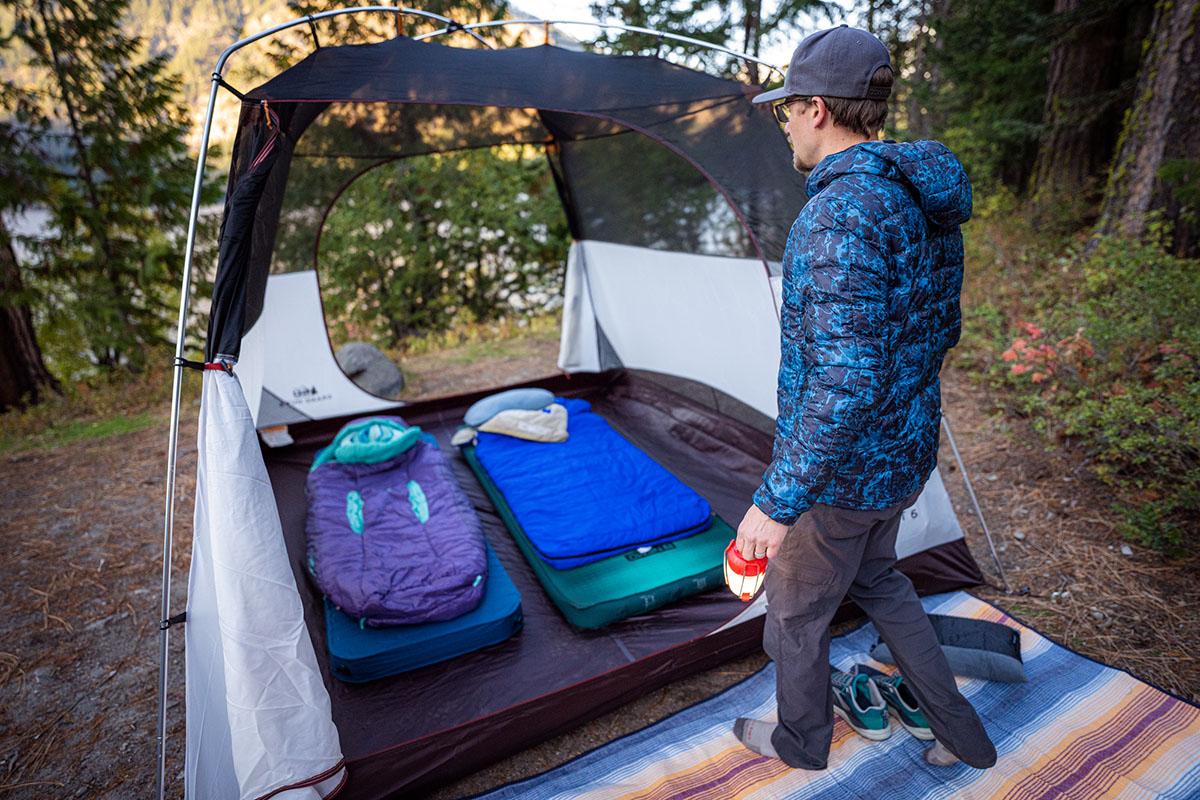
The majority of camping mattresses are self-inflating and utilize a familiar twist valve. Opening the valve allows the pad to work its self-inflating magic and expand the foam. Depending on the model, you may or may not need to blow a few extra breaths to get the mat fully inflated. We’ve found that the quality of the valve does vary by price, and budget pads like the Coleman Self-Inflating Sleeping Pad have a flimsier plastic than premium options from REI or Therm-a-Rest, which impacts long-term durability. In addition, some of the large self-inflating pads, like the Exped MegaMat or Therm-a-Rest MondoKing, have two valves to shorten inflation and deflation times.
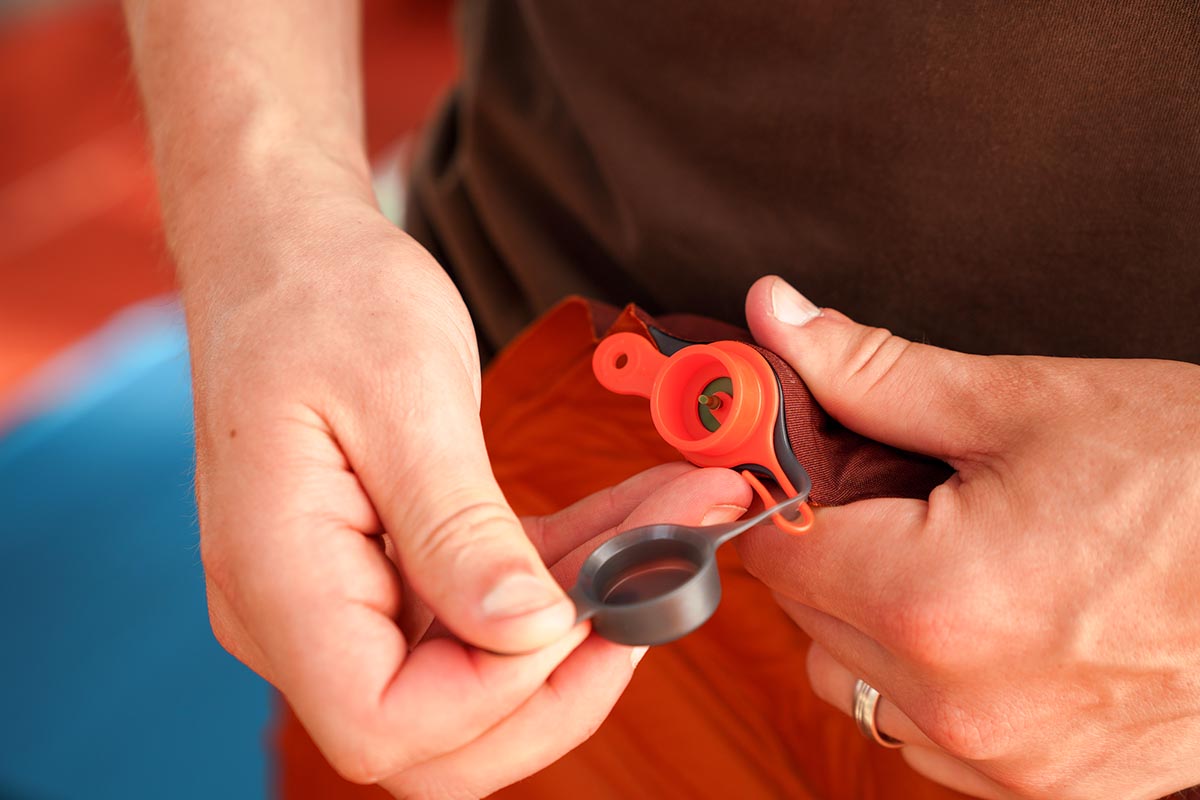
Having to manually inflate a large air pad or air bed can be a time-consuming and dizzying experience (or an impossible task in the case of an air bed), so most manufacturers will include some sort of pump. For instance, Nemo's Quasar 3D can be inflated easily by opening the stuff sack, connecting it to the mat, and folding the bag over to force air into the pad (very little breath required). Overall, we’ve found that air pad pumps aren't as simple as a self-inflating design, but they fully inflate their respective sleeping mats in only a few minutes.
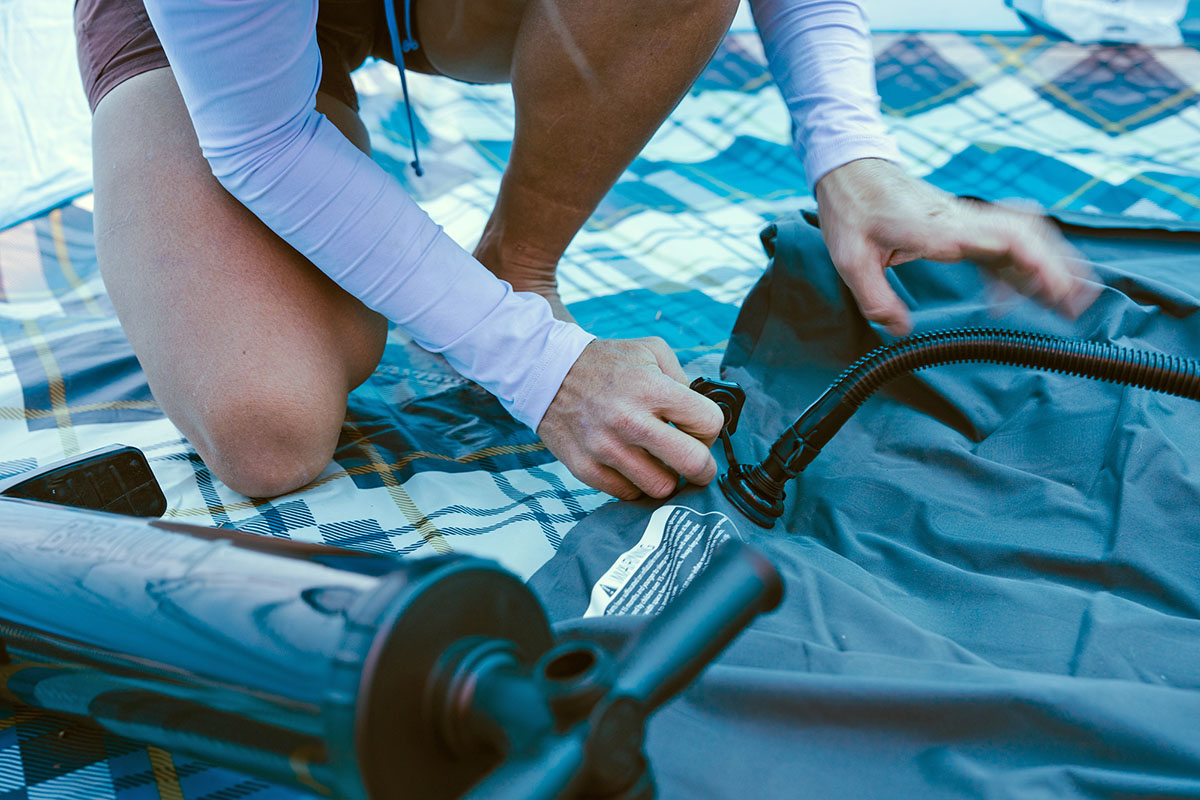
The outdoor apparel world has seen a sizable uptick in the use of sustainable practices in recent years, and camping mattresses are no exception. Recycled materials are the most common measure, as seen in pads like the REI Co-op Trailmade and Camp Dreamer XL, Nemo’s Quasar 3D and Roamer, and Exped’s Dura 8R. The Quasar and Roamer are also certified as bluesign-approved, indicating that the materials and chemicals used during production meet strict environmental and health standards, and the Dura uses down certified to the Responsible Down Standard (RDS), which ensures the birds were treated humanely (e.g., no force-feeding or live plucking). A final way to shop sustainably is to buy from a Climate Neutral Certified brand like REI Co-op, who has made significant efforts to reduce—and eventually eliminate—greenhouse gas emissions during production and delivery.
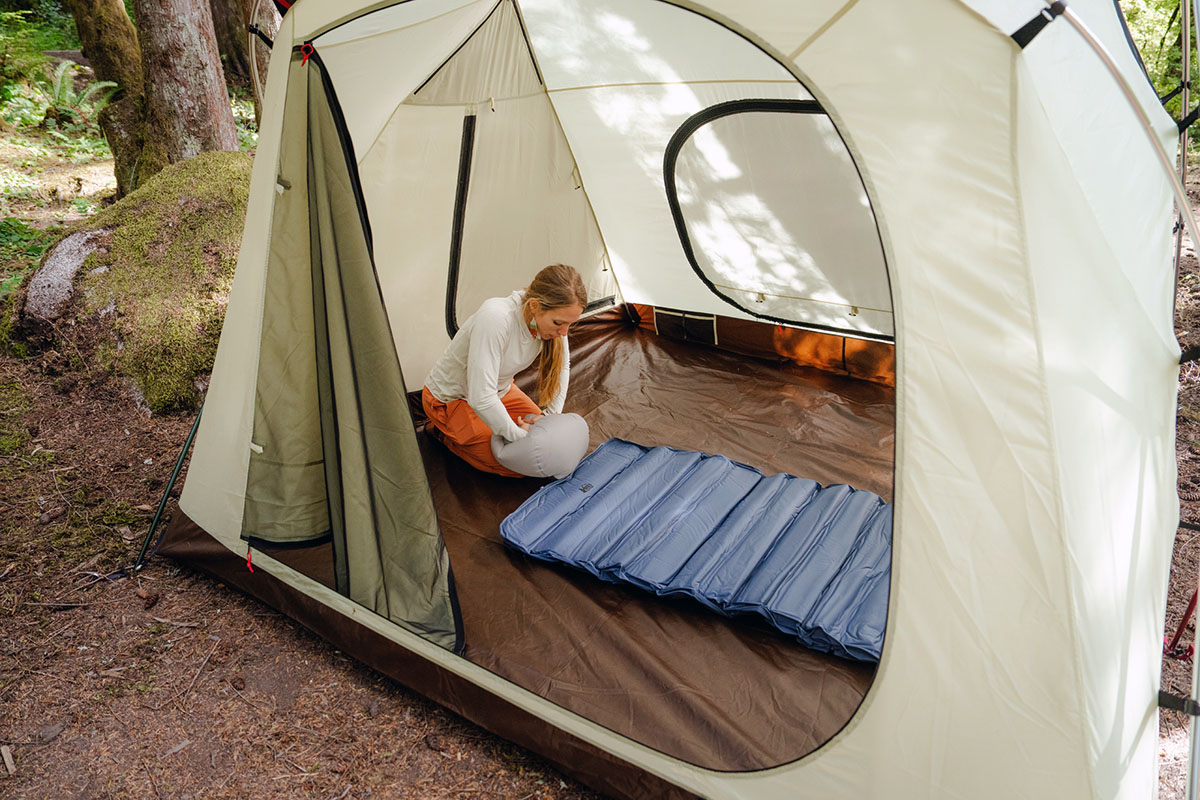
A final camping mattress consideration is how and where you’ll be storing it between trips. To maximize lifespan, it’s best to leave your self-inflating pad unrolled and with the valves open. This can create some challenges with a huge mattress like the Exped MegaMat Duo 10, but one possible location is storing it under a bed (provided you have the space). If you must leave a self-inflating pad rolled up in its bag, try to do your best to occasionally let it self-inflate to avoid long-term damage to the open-cell foam. Air mats are easier: When finished, open the valve, release all the air, and keep it in a storage sack to avoid accidental punctures. Finally, closed-cell foam pads require the least attention, although you’ll want to be sure not to leave any heavy objects on top of them that will compress the material.
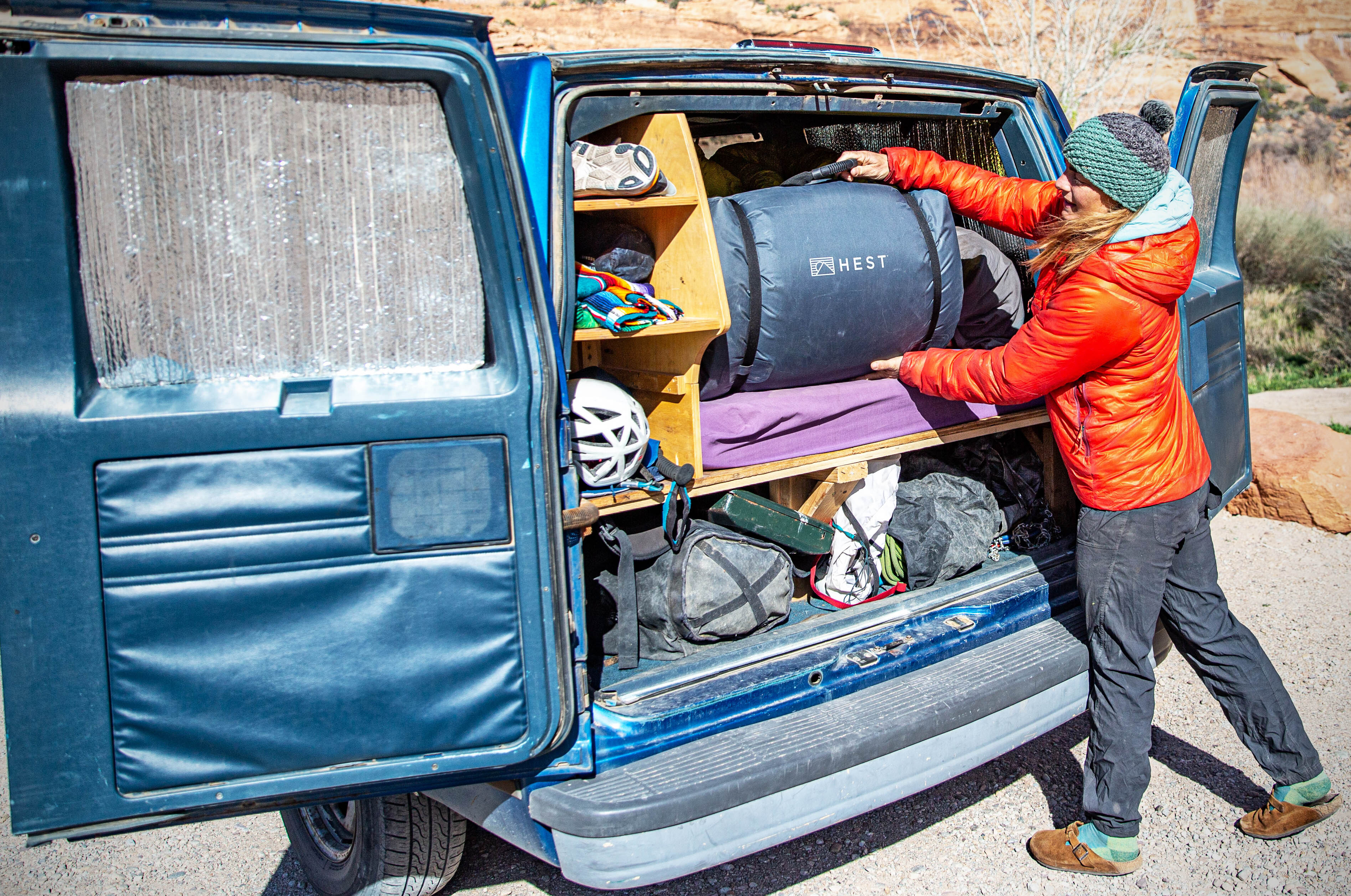
Sleeping pads designed for backpacking are about keeping weight as low as possible, while retaining enough warmth and comfort. The downside of then using your lightweight backpacking pad while camping is that it’s another opportunity for the thin fabrics to spring a leak. It’s strange to say, but we’ve found that the easygoing camping life can actually be more damaging to your lightweight gear than being in the backcountry. Whatever the reason, we’ve had backpacking pads that never leaked catch a dog’s nail or other hazard and deflate on the simplest of camping trips.
We do understand the financial motivation to only purchase a single pad, and there are options that cross over nicely. Of the mattresses that are most comfortable for camping, we recommend Nemo's Quasar collection and Sea to Summit’s Comfort Light designs. For a full list of our recommendations, see our article on the best backpacking sleeping pads.
Back to Our Top Camping Mat Picks Back to Our Camping Mat Comparison Table